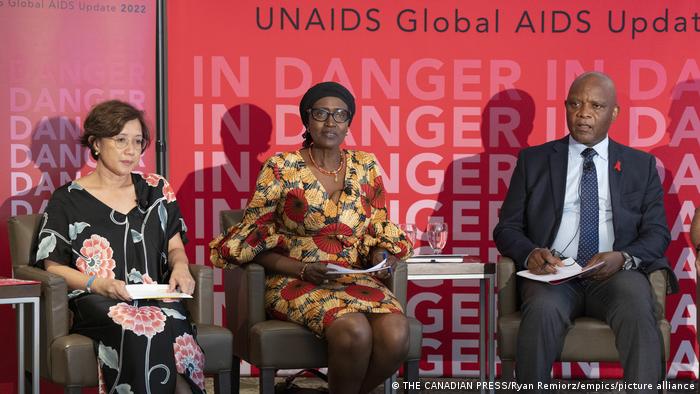HIV/AIDS need billions in funding to avoid 'deep trouble'
About 1.5 million people got HIV in 2021 — a million more than predicted. Experts say AIDS programs "suffered" due to COVID and we have to get back on track.

Experts say health programs need $18 billion in funding to get HIV/AIDS, TB
and malaria targets back on track after the COVID pandemic
The coronavirus pandemic has changed a lot in a very short space of time, including our global strategies to slow the spread of — and help treat people with — HIV and AIDS. And we were doing so well.
"In West and Central Africa and in the Caribbean, we [saw] substantial declines in new infections," Winnie Byanyima, the executive director of UNAIDS in Geneva, wrote in an email to DW.
"Globally, 26 million people are on HIV treatment in low and middle-income countries, which is an accomplishment that seemed unimaginable just a few years ago," Byanyima wrote.
HIV infection rates on the rise
UNAIDS published a report in late July showing that HIV infections were rising significantly, with 1 million more cases reported in 2021 than estimates had predicted.
The report highlights an increase in HIV infections in Eastern Europe, Central Asia, the Middle East, North Africa and Latin America.
There were 650,000 deaths associated with AIDS in 2021 — that is more than one death every minute.

Winnie Byanyima (center) releases the UNAIDS 2022 update on AIDS at
an international AIDS conference in Montreal, Canada, on July 27, 2022
Pandemic contributed to higher HIV rates
UNAIDS says infection rates started to rise after global resources were diverted away from AIDS to tackle the coronavirus pandemic.
"In many countries, the AIDS response was [redirected] to tackle COVID. This meant a more successful COVID response, but there weren't the resources to focus on both at the same time. The result was that the AIDS response suffered," said Matthew Kavanagh, deputy executive director at UNAIDS.

Staff and resources were diverted away from the AIDS response to tackle COVID-19
But gender, economic and racial inequalities continue to play their part in HIV infection rates.
For example, new infections disproportionately affect young women and adolescent girls, mostly in African countries, where young women are three times more likely to contract HIV than young men.
In richer countries, HIV rates are higher among people of color than white people. That is true for the US and UK, including in indigenous communities in Australia, Canada and the US.
The UNAIDS report also found that men who have sex with men have 28 times the risk of acquiring HIV compared with men of the same age and gender who do not have sex with men.
Some HIV prevention programs still had sucess
Despite the setbacks during the pandemic, Byanyima said, there are examples of resilience in HIV programs and success.
There were, for instance, successful rollouts of antiretroviral treatments in Cote d'Ivoire, Malawi and Kenya, and that contributed to a decline in new adult HIV infections.
"South Africa and Nigeria were able to achieve large reductions in new HIV infections despite serious disruptions from COVID-19," Byanyima said.
And, on the flip side, AIDS programs helped fight COVID-19 — "with contact tracing, laboratories and public health education," she said. "Investments to tackle the AIDS pandemic proved very effective in preparing for a new pandemic, often more so than in the world's wealthiest countries."
A new HIV prevention drug is ready to roll
Kavanagh highlighted a new drug called long-acting injectable cabotegravir (CAB-LA). The drug can be injected every 2-3 months to prevent HIV infection.
It works by blocking the HIV genome, which means that the virus is prevented from integrating itself into human DNA and that stops it from replicating. So, it can't spread and take hold in the body.
Experts hope that CAB-LA will build on the success of PrEP or pre-exposure prophylaxis. PrEP is a pill that reduces HIV transmission through sex or intravenous drug use.
A recent study in Kenya showed how PrEP had reduced HIV incidence by 74%. But the pill only works in men.
Research suggests that, compared with PrEP, CAB-LA may be better at reducing HIV transmission and that it is effective in men and women.
The WHO advises countries to adopt CAB-LA in their strategies to prevent the spread of HIV, but notes that it is currently too expensive for most people.
"If the drug [becomes] affordable for low-and-middle income countries, we can roll it out across the world to reach those who need it most. It can be an inequality buster," Kavanagh said.
Experts are also watching HIV vaccine development with renewed optimism after three new mRNA HIV vaccines began trials in March 2022.
Gathering the political will
Byanyima and Kavangh say HIV/AIDS programs need renewed support from politics.
"We need the political will to raise funds to get HIV prevention technologies and strategies out," Kavanagh said.
The Global Fund to fight AIDS, tuberculosis and malaria is asking global leaders for $18 billion (€17.6 billion) to tackle these health issues.
It would be a major success if global leaders pledged the money in the coming months, with the global economy in the state that it is.
"If [they do], we can get the HIV response back on track, but if [they don't], we will be in deep trouble. We'll face another pandemic," Kavangh said. "I can't think of a time when it's been more important."
Edited by: Zulfikar Abbany
No comments:
Post a Comment